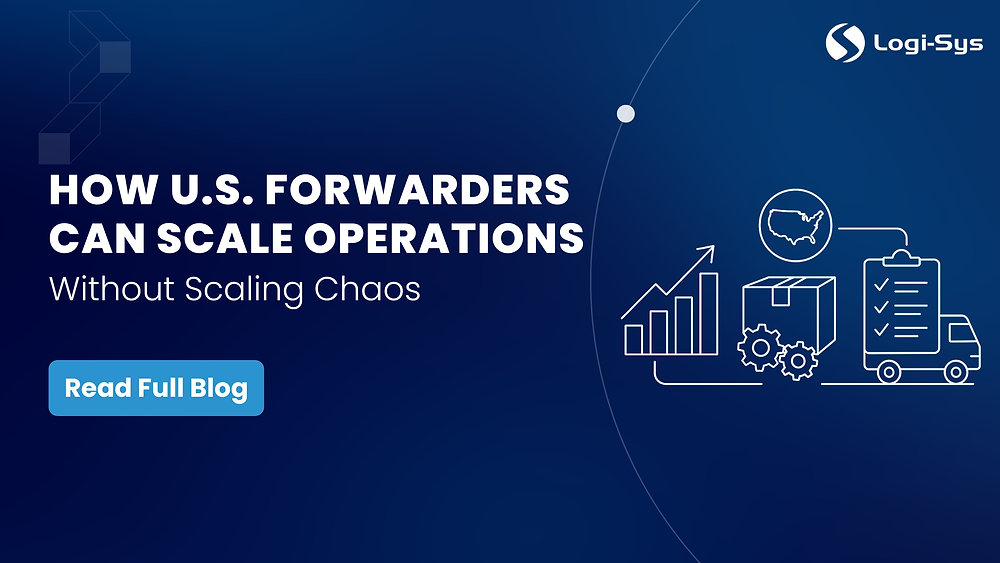
Growth brings opportunity, but also entropy. For U.S. based freight forwarders, scaling up often means drowning in duplicated data, disconnected systems, and disjointed teams. More clients, more shipments, more complexity. What should be a strategic advantage turns into operational chaos.
It’s not that forwarders lack tools. It’s that most of those tools don’t talk to each other.
This is why more U.S. logistics businesses are rethinking their technology—not as a patchwork of apps, but as a unified platform. The shift isn’t just digital. It’s structural. And it starts with adopting purpose-built freight forwarding software that replaces silos with sync.
Scaling Isn’t a Headcount Problem, It’s a System Problem
Hiring more staff can handle short-term spikes. But as volumes grow, process friction surfaces:
-
Manual duplication across booking, billing, and finance
-
Gaps between shipment milestones and customer communication
-
Disconnected job costing and invoicing
-
Poor visibility across branches and departments
These aren’t growth pains—they’re fragmentation pains. Solving them requires a centralized, task-aware freight management system that operates on a single source of data. One that eliminates repetitive tasks, streamlines workflows, and gives every department access to live information—without compromise.
What Software for Freight Forwarders Needs to Deliver
Freight forwarding isn’t generic. Your software shouldn’t be either. U.S. forwarders deal with complex documentation, multi-modal jobs, tight regulatory compliance, and multi-branch coordination.
-
Handle exports/imports across air, sea, and road
-
Automate documentation (AWB, BL, HBL, cargo manifests)
-
Track job margins and trigger billing from operational milestones
-
Provide full financial control: P&L, multi-currency, receivables
-
Integrate CRM: lead tracking, quotes, conversion analytics
-
Offer U.S.-specific compliance: AMS, ISF, and tax alignment
-
Deliver visibility to internal users, customers, and vendors through portals
Anything less creates a disconnect between effort and output. And in a market where service levels are as important as rates, that disconnect becomes a cost.
Logi-Sys: Structuring Growth with Unified Freight Intelligence
Logi-Sys is an intelligent cloud-based freight management system tailored for forwarders who want to grow operations—without growing complexity. Designed for global and multi-branch use, it aligns every part of the freight lifecycle in one platform: operations, accounting, sales, compliance, and customer service.
Here’s how Logi-Sys makes scaling not just possible, but clean.
1. Multimodal Freight Execution
Supports all job types—consolidated, direct, back-to-back—across air, ocean, and road. Each job is tracked with real-time updates and system-generated documentation. Operations and finance are inherently linked; no duplication, no missed steps.
2. Built-In Financial Accounting
Not an add-on. Logi-Sys includes a full financial module that manages:
-
Multi-currency invoices and collections
-
Profit per job, branch, and customer
-
Automated tax handling and audit reports
-
Credit control and payment follow-ups
Finance works off the same data as operations—no gaps, no manual transfers.
3. Sales CRM Integration
Manage leads, generate quotes, track conversions, and analyze campaign ROI. Sales activities are linked to jobs and invoicing—delivering full visibility from pipeline to P&L.
4. U.S. Compliance: AMS and ISF
Stay fully aligned with U.S. import regulations:
-
AMS (Automated Manifest System) submissions for air and ocean
-
ISF (10+2) filings for ocean imports
-
Real-time tracking of filing status, acknowledgments, and audit history
-
Direct link to shipment records for seamless validation
5. Portals for Customers, Vendors, and Agents
Customers access live shipment updates, invoices, and documents. Vendors upload bills and track payments. Overseas agents collaborate in shared job files—reducing email dependency and speeding up turnarounds.
6. Digital Document Management
Every document—BL, invoice, certificate—is stored, secured, and version-controlled. System-level locks, edit controls, and sharing permissions ensure compliance and traceability.
7. Mobile Access & Alerts
Team members receive alerts for pending jobs, overdue tasks, and critical approvals. Approvals, updates, and customer communication can happen via mobile—ideal for fast-paced environments.
8. Network & Branch Visibility
Consolidated dashboards show profitability, receivables, and job status across branches. Multi-branch billing, inter-office reconciliation, and centralized control make scale manageable.
9. Task-Level Operational Discipline
Logi-Sys defines internal workflows with role-based task assignments and alerts. This eliminates dependency on follow-ups and helps teams adhere to internal SLAs.
10. Data Security & Access Control
Role-based access, data locks, compliance audit trails, and period closures are all standard—ensuring your data is secure, trackable, and compliant.
For U.S. Forwarders, It’s Not About More Tools—It’s About the Right One
More apps won’t fix inefficiencies. What U.S. forwarders need is alignment: one freight forwarding software that covers everything from quotation to delivery, documentation to receivables, visibility to performance.
Final Word: Structured Growth Starts With Unified Systems
Growth is inevitable. The question is whether your systems are designed to handle it. Without a unified platform, every new shipment adds more emails, more handovers, and more risk.
With Logi-Sys, you’re not just growing: you’re building infrastructure that scales with you.
